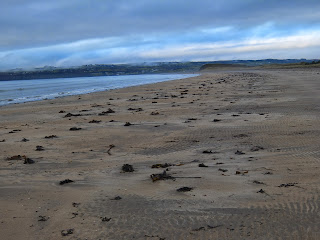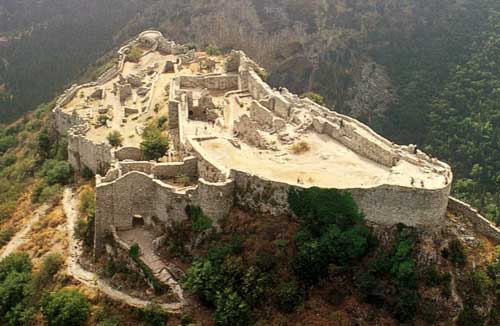On a recent trip to India I re-read M.M.Kaye's The Far Pavilions, a beautiful novel of romance and chivalry set in Afghanistan and Rajasthan during the 19th century. It was my fourth trip to India and this time I was visiting neither of these places but, rather, Hyderabad in the Deccan region. Hyderabad was once India's most beautiful city. Indeed, in many ways it still is. Beyond the frenetic markets, the wilderness of traffic, the haze of pollution, not far from the old city, whilst exploring a 16th century fort, I discovered romance.
 |
The Golconda Fort
|
The Golconda Fort, situated 11km west of Hyderabad on Shepherd's Hill, projects an atmosphere of long ago intrigue and trysts. Today, it retains a ghostly echo of an exotic and a hint of a dangerous past that lingers in the present. It emanates from thick walls, corridors, deserted rooms, steps, stone carvings and dried up fountains. Romance is trapped within its ruined courtyards, the once heavenly and scented gardens, its intricate harem quarters, and in the sinister great Hall of Judgement where the Nizam would sit on his throne within a stone balcony, high above the populace, ready to pronounce judgements and thus make or destroy the fragile lives summoned into his autocratic presence.
 |
Entry into the Hall
|
It is easy to remember great Indian epic poetry here, that sourced from history and legends; poetry that contains the markers of history, if embellished; these were poems of bravery, love, great deeds, glory, sacrifice and death.
During the period of the Raj the sultanates of Bijapur and Golconda between them retained control over central and southern India. As William Dalrymple writes in his book, White Moghuls, set in the region:
'the great city states of the Deccan-like those of Renaissance Italy- were always more eclectic and open to outsiders than even the cosmopolitan Imperial Moghul courts in Agra.'
Relationships between Hindus and Muslims were easier in this region than in the north. For example, middle eastern immigrants from the 16th C on turned the Deccan into the greatest centre of Arabic learning and literary composition beyond their homelands.
 |
| The Hope Diamond |
The area around Hyderabad was wealthy as it was famous for gem mines. The Hope Diamond was produced here and also the Idol's Eye and the Koh-I-Noor. I am not wealthy enough to purchase diamonds, but I admit it, I did fall for a creamy string of pearls. These are available everywhere and of excellent quality. John Keat's beautiful and reflective poem 'On Receiving a Curious Shell' opens with the lines: Hast thou from the caves of Galkonda, a gem/ pure as the ice-drop that froze on the mountain'.
The beginnings of the fort date to 1143 during the Hindi supremacy. It fell into disrepair until the Moghuls conquered the region around 1507 and as a consequence expanded what was once a mud fort into a massive fort of granite with crenelated ramparts. It is 5 km in circumference. Certainly walking over this ruined fort today is not for those in flipflops or high heels. Wear sensible walking shoes and carry water. There is a long climb up hundreds of steps to the top. Discovering this fort's every interesting nook and ancient corner is impossible. This is not a great loss, since its16th century Moghul architectural beauty is evident in its exterior pavilions, gates, entrances and domes. There are apartments, halls, temples, mosques and stables, all of them haunting ruins.
 |
| the fortress covers a huge site |
This great fort is known for its magical acoustic system. A sound made at the entrance can be heard a kilometre away at the highest point. It is also believed that there is an underground tunnel that leads from the Durbur Hall to end in one of the palaces at the foot of the hill. I cannot help but wonder could this have been used for secret romances or for narrow escapes from displeasure. Does the fort and its palaces have its own long forgotten stories reflective of M.M Kaye's famous novel?
The palace buildings have a perfect natural ventilation system with fabulous and exotic designs at every turn. This is so intricately executed that cool breezes can reach the interior of the fort, even during the intense heat of summer. Finally, an incredible water system dating from the 16th C was designed to pipe hot water into the palaces, cold water also and yes, oh yes, ladies, rose water for your pleasure. Now, how sophisticated was this way back in the 16th C.
The Golconda Fort and its palaces tempt one to dream of the past; to imagine tales of long ago lovers. Today the fort is the haunt of romancing couples, though if they are caught they may face strange consequences. It was, for instance, reported in a local paper that one such couple faced a bizarre punishment of enforced press ups when they were caught smooching around the decayed corridors.
The answer is obvious, find a hidden place amongst the ancient stones and do not get caught. The nature of romance and chivalry found in The Far Pavilions may not in the 21st century involve such extremes as suttee but romance is still very alive in The Golconda Fort and I doubt that a few press ups will be any deterrent to what was then and of what it is to be human, namely to love and to be loved.
 |
| The Handfasted Wife by Carol McGrath published by Accent Press |


















.jpg)











.jpg)


.jpg)



.jpg)




.jpg)